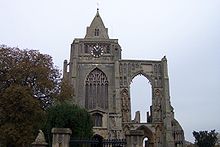Guthlac

Guthlac (* 673 ; † April 11, 714 in Croyland , England ) was an English hermit and saint . His life is known through the vita written by the monk Felix.
Life
Guthlac, son of Penwald and Tette, came from a noble Anglo-Saxon family. His birth was indicated by wonderful omens and Guthlac was already noticed as a child for his extraordinary piety. After a few years as a warrior, he entered the monastery of Repton Abbey in Derbyshire at the age of 24 . But soon he became bored with monastery life and he decided to follow the example of the oriental desert saints and retired to the island of Croyland with the boatswain Tatwin and his servant Beccelm 699 . According to Guthlac A, this was one of several wooded islands in the black water of the Fens , in the Markland ( mearclond ) between Cambridge and the North Sea.
He dressed in furs and lived in a burial mound in a "hidden place" ( duggle stowe ) in a clearing in a wasteland ( anade ). The burial mound ( beorg ) consisted of clods of earth and contained a stone chamber. Whether it was a Neolithic long bed , a Roman burial mound, a Bronze Age stone box or even a pagan Anglo-Saxon burial mound with built-in wood is controversial in research. The hill was destroyed during the construction of the cathedral. Guthlac covered the stone chamber to live in this beorgseƿel and erected a wooden cross on the top of the hill. An angel gave him helpful instructions. The tumulus was the ancestral home of numerous demons who had looted its treasures and were understandably angry with the pious squatters and his unauthorized modifications. According to Felix's description, they had large heads, thin faces, a yellowish complexion, long necks, shaggy ears, horse teeth, knotty knees, swollen ankles and splayefeet. They tried to placate Guthlac and make it clear to him that no one would bring him food here in the swamp. They then emphasize that the hill is their only refuge, the only place where they can rest, but also that Guthlac, whom an angel supported in the dispute, did not move to move. He insisted that this hill be his dwelling place until he moved into the heavenly Jerusalem . The demons then tried him by showing him the good life of the monks in a nearby monastery and, when that didn't work, dragged him to the gates of hell , where they threatened him with eternal damnation. But St. Bartholomew , the patron saint of Guthlac, drove them out and gave him a whip to fend off them from then on. A manuscript in the British Library (Harley Roll Y.6) shows Guthlac with the whip fighting the now homeless demons.
Guthlac fasted during the day and at night only ate barley bread and drank swamp water. Not surprisingly, he was repeatedly attacked by malar fever . Guthlac made friends with the animals in the area and fed the birds that ate out of his hand. On the other hand, he had little contact with the locals; he regarded them as savages. His sister Pega finally persuaded him to eat during the day, which he expelled from the island.
Soon he fell into the fame of holiness and multitudes of pilgrims visited his burial mound. Also Aethelbald , the nephew of Penda in front of his cousin Ceolred of Mercia had fled, spent some time in the hermitage. Bishop Hedda went to see him and ordained him a priest. Guthlac predicted his death after 15 years and died after seven days. His sister Pega buried him in his oratory which Hedda had dedicated.
After his death Guthlac Æthelbald appeared in a vision and foretold that he would become king of Mercia , which came true. Numerous miracles occurred at his grave.
On the site of the hermitage, Æthelbald had the Croyland Abbey built in 716 in fulfillment of a vow according to Ordericus Vitalis . Kenulph of Evesham became the first abbot . The monks followed the rule of St. Benedict . A Norman archway from the 12th century is worth seeing. Today the north aisle from the 15th century is used as an Anglican parish church.
Guthlac's feast day is April 11th. He is considered the patron saint of archaeologists .
swell
- Felix, Vita Sancti Guthlaci
- Ordericus Vitalis, Historia Ecclesiastica
- Pseudo-Ingulph (1076–1109), "History of Croyland" from the 14th century.
- Cynewulf , biography in verse, Codex Exoniensis (Guthlac B)
literature
- Laurence K. Shook, The Burial Mound in "Guthlac A". Modern Philology 58/1, 1960, 1-10.
- H. Forstmann, “Investigations on the Guthlac Legend”, Bonner Contributions to Anglistics 12, 1902, 1-40.
- Bertram Colgrave, Felix's Life of Saint Guthlac (Cambridge, 1956).
- John FX Murphy: St. Guthlac . In: Catholic Encyclopedia , Robert Appleton Company, New York 1913.
Web links
- http://www.georgetown.edu/labyrinth/library/oe/texts/a3.2.html
- http://www.umilta.net/guthlac.html about the sources
- http://www.crowlandabbey.org.uk/ Croyland Abbey website ( English )
| personal data | |
|---|---|
| SURNAME | Guthlac |
| BRIEF DESCRIPTION | English hermit and saint |
| DATE OF BIRTH | 673 |
| DATE OF DEATH | April 11, 714 |
| Place of death | Croyland , England |
